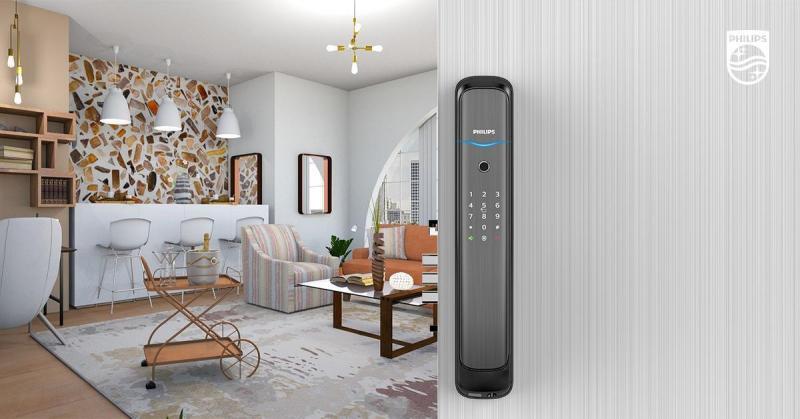What Is Face Recognition Door Lock?
To secure our home’s shield, the door, we must pick a safe lock. The transition from mechanical locks to digital ones is significant in today’s high-tech environment. Modern locks have several distinct benefits, including face recognition technology.
Face recognition is a complex technique that assesses human faces as familiar to the program. A user’s face is photographed and added to a database after being captured by the system.
When that individual unlocks the door again, facial recognition technology scans and compares the face to the database. This article aims to explain how a face-recognition door lock works and its benefits, focusing on the advanced features. Furthermore, when we discussed smart locks, The Philips Smart Lock is, without a doubt, a great choice.
How Face Recognition Works?
For decades, machine learning and artificial intelligence have been the foundation of facial recognition technologies. When a person’s face is programmed into the lock, an exact picture is taken utilizing the RGB color spectrum.
Using this image as input, AI does millions of face-wide floating point calculations to generate a one-of-a-kind facial signature. When the user engages in the door access protocol, the embedded camera captures a picture of their face and matches it to this signature.
Due to floating point calculations, the same person may unlock the door using a different phrase. Machine learning (AI)-trained computers can detect and confirm the user’s individuality.
Can an Image be Used to Open a Door that Requires a Key?
Experts indicated that face recognition is complex since the algorithm must determine whether the detected human face matches one of the previously stored faces. Biometrics are far superior to other forms of authentication, such as passwords. There is no such thing as a “good” or “bad” password. However, biometrics can only provide an approximate figure of how confidently the identification can be made.
Depending on the setup, a printed picture may be able to deceive certain smart locks. Infrared dots projected onto the user’s face create a three-dimensional representation of the user’s head, as seen in iOS devices. Additionally, facial motion is analyzed to rule out the possibility of a static 3D head model.
Therefore, investing in a lock with a face recognition system guarantees that a photograph won’t be able to bypass security measures. When you want to invest in smart locks, you can purchase Philips Smart Lock because it is the best choice in innovation.
What are the Benefits of Using Face Recognition for Household Safety?
The door may be unlocked with just a look thanks to digital locks that use facial recognition technology. Facial recognition technology has advanced to the point where you can unlock a door by just positioning your face in front of the lock’s camera.
Facial recognition technology has great advantages and technological specifics. Let’s take a look at the benefits of using a top-notch access system, such as the Philips smart Lock that works with your face.
- Spending Less Time on It
The conventional method of unlocking a door involves taking the key out of your pocket, inserting it into the lock’s slot, and turning it. However, it might take digital locks a few seconds to open using face recognition. As a consequence, the user experience is streamlined.
- Take Away Your Keys
The loss of a key is reason for concern since it is an important object that requires special attention. Making and sending out duplicate keys to family escalates the risks of losing track of them. The digital locks from Philips can remember over a hundred different keys. The door will be easy for you and your loved ones to open and enter.
- Extraordinary Safety
Face recognition is a robust feature that correctly detects the person’s face and expression to open the door, whereas a PIN or password might be exploited by someone who may have seen it.
- Old age
Even while fingerprints don’t change as we age, capturing them might be trickier. With aging comes a loss of elasticity in the skin, which causes the patterns to fade, particularly when ridges and furrows deepen. In this scenario, facial recognition could work better.
What are the Drawbacks of Using Face Recognition?
Although advancements in facial recognition technology have been made, they do not come without criticism. Some people have voiced concerns about accuracy, security, and the possibility of hacking. Things like altered face features or poor lighting may also hinder recognition.
- Personal Data Protection Issues
Through Closed-Circuit Television (CCTV) systems, law enforcement agencies can use facial recognition technology to pursue criminals. Yet, they could also trace whomever they chose, wherever, anytime.
Facial recognition systems may analyze millions of pictures and videos from various sources. Things like closed-circuit television, mobile phones, social media, and the internet fall into this category.
Governments may use face recognition for bulk identification purposes. Some people are concerned that privacy rights might be abused without adequate safeguards. Companies who want to use facial recognition should think carefully about overcoming these issues.
As a result, you may prevent bad press and silence critics of your face recognition system without delivering the incorrect message to your consumers.
- Facial Recognition Raise Privacy Concerns
The privacy of personal information is another issue with face recognition. Millions of photos and videos have been used as face recognition data. Additionally, it includes the “maps” produced by facial recognition technologies. In the end, facial recognition information is kept in databases, often on the cloud. It can be hacked just like any other computer system.
Information used for facial recognition might be compromised in the event of a data breach. Identity theft is still possible, even if systems are improving at stopping it.
How to Pick the Face Recognition Door Lock?
There are a few things to keep in mind while picking a home facial recognition door lock:
- Precision and Dependability:
Look for a program that uses an effective recognition method and has a high success rate.
- Features for Safety:
Make sure no one can hack into the system by employing effective encryption.
- Compatibility:
Make sure the lock will work with your other smart home devices and internet service.
- An Easy-to-Use User Interface:
An intuitive interface might be helpful for everyone in the household.
Conclusion
A face-recognition door lock is a significant technological advancement for home safety. Their promise to improve access control and the simplicity of their implementation makes them hard to dismiss. Consider the pros and downsides of such technology before investing.
If you’re looking for a smart lock at a reasonable price, the Philips Smart Lock is a top pick. These systems will likely become standard in home security as research continues and problems are resolved.




